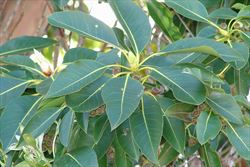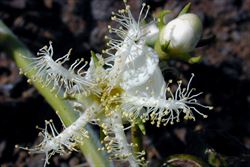Click on images to enlarge

habit (Photo: Sheldon Navie)

glossy-green leaves (Photo: Sheldon Navie)

leaves (Photo: Forest and Kim Starr, USGS)

flowers (Photo: Sheldon Navie)

close-up of flower showing stamens arranged in five elongated clusters 10-20 mm long (Photo: Forest and Kim Starr, USGS)

immature fruit (Photo: Sheldon Navie)

old fruit (Photo: Forest and Kim Starr, USGS)

the similar swamp box (Lophostemon suaveolens), with finely hairy new growth and flowers that have smaller clusters of stamens 3-5 mm long (Photo: Sheldon Navie)
Scientific Name
Lophostemon confertus (R. Br.) Peter G. Wilson & J.T. Waterh.
Synonyms
Tristania conferta R. Br.
Family
Myrtaceae
Common Names
Brisbane box, brush box, brushbox, Queensland box, Queensland brush box, red box, scrub box, vinegar tree, vinegartree
Origin
Native to the coastal and sub-coastal districts of eastern Australia, from northern Queensland to north-eastern New South Wales.
Naturalised Distribution
Naturalised beyond its native range in the coastal districts of central New South Wales.
Also naturalised overseas in Hawaii.
Notes
Brush box (Lophostemon confertus) is regarded as an environmental weed in the wider Sydney and Blue Mountains region. This native species grows naturally around the edges of rainforests and in most types of eucalypt forests in the eastern Queensland and north-eastern New South Wales. It is deliberately cultivated in other parts of Australia as a street tree, and has recently become naturalised in urban bushland around Sydney. For example, brush box (Lophostemon confertus) plants have been noted becoming established in bushland in Royal National Park and in Mosman.

